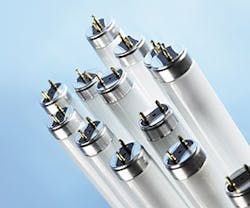Relamping Gone Wrong: New Standards Could Impact Your Replacement Plans
So what should facility managers do when faced with the need for new lighting?
An estimated 112 million 32 watt T8 tubelight bulbs were sold in 2017 alone, but 70 percent of them don’t comply with new Department of Energy (DOE) lighting efficiency requirements.
All general service fluorescent lamps are now required to deliver higher efficacy, as measured in lumens per watt (see table below), and lamps that don't meet the mark can no longer be manufactured.
What does this mean for lighting projects?
In the short term, not much. The mandate only applies to manufacturers making new lamps, not retailers or end users, so you’re free to purchase whatever works for your building. There are also plenty of fluorescent T8 tubelights available, so the new standard doesn’t have to mean an expensive upgrade.
So the next time you order lamps, you’ll have three options:
- Stock up on noncompliant lamps. The old T8 tubelights won’t disappear from the market right away. They just can’t be manufactured anymore, so the existing supply will slowly dwindle. You can still buy noncompliant 32 watt T8s as long as vendors still have them in stock, explains Elaine Miller, Commercial Lighting Programs Manager for the Northwest Energy Efficiency Alliance, a partnership of more than 140 utilities and efficiency organizations in the Northwest.
- Switch to fluorescent T8s that comply with the standard. There are two ways to accomplish this, Miller explains: use energy efficient lighting with the same wattage but a higher efficacy, or switch to 28 watt lamps with the same efficacy you’re used to. “All of the major manufacturers have come out with a compliant 32W product, so it’s the same wattage. They just bumped up the efficacy to comply because it’s an efficacy standard, not a wattage standard,” Miller says. “However, if you have to switch to a new product or model number anyway, why not take advantage of the low-wattage options? You’re going to get the same level of light you did with your old 32W lamps, but save 3W in every lamp. If you buy thousands of these every year, that adds up quite a bit.”
- Upgrade to LED products. If your budget allows, you can avoid the periodic updates to fluorescent lamp standards entirely by installing LED lighting. LEDs deliver even more lumens for every watt they consume, so your power consumption will drop significantly. An LED T8 tubelight meant to replace a 32 watt fluorescent generally consumes 15 to 18 watts.
“Don’t just be habitual and buy the product you’ve been buying all the time,” Miller adds. “Say, ‘I want better efficiency,’ and ask for low wattage.”
Janelle Penny [email protected] is Senior Editor of BUILDINGS.
About the Author
Janelle Penny
Editor-in-Chief at BUILDINGS
Janelle Penny has been with BUILDINGS since 2010. She is a two-time FOLIO: Eddie award winner who aims to deliver practical, actionable content for building owners and facilities professionals.

